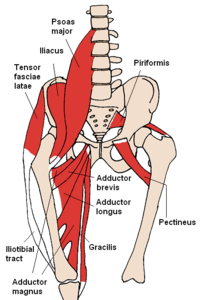
Photo from wikipedia
BACKGROUND Subscapularis (SSC) tendon tears are a challenging problem because they can significantly alter shoulder mechanics and function. Tendon retraction and advanced fatty degeneration associated with a chronic tear may… Click to show full abstract
BACKGROUND Subscapularis (SSC) tendon tears are a challenging problem because they can significantly alter shoulder mechanics and function. Tendon retraction and advanced fatty degeneration associated with a chronic tear may make it irreparable. Tendon transfers options for such tears are viable, but results in the setting of associated glenohumeral instability are inconsistent. With the potential to recreate the SSC line of pull, the teres major (TM) may be a viable option for transfer. This cadaveric study investigated the feasibility and outlined the steps of a bipolar, pedicled TM transfer for irreparable SSC tendon tears. METHODS Eight fresh frozen cadaver torsos from 4 women and 4 men (average age, 84 years; range, 68-96 years) were dissected. Anatomic details comparing TM to SSC were examined, including muscle width, length, thickness, and line of pull in the scapular plane. In addition, a surgical technique was described for implementing the pedicled TM transfer. RESULTS Measurements between the TM and SSC were comparable, with the exception of muscle belly width, which was significantly greater in the SSC. With transfer of the TM, there was no impingement or tension on the brachial plexus or the neurovascular pedicle of the TM. The line of pull of the TM relative to the SSC had a difference of 9°. CONCLUSIONS This study demonstrates that a bipolar TM tendon transfer is an anatomically feasible option for reconstruction of an irreparable SSC tendon tear. Further clinical studies are necessary to understand its outcome in in vivo conditions.
Journal Title: Journal of shoulder and elbow surgery
Year Published: 2018
Link to full text (if available)
Share on Social Media: Sign Up to like & get
recommendations!